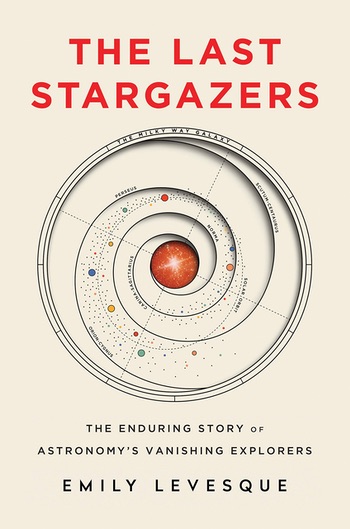 |
by Jeff Foust
Monday, September 21, 2020
The Last Stargazers: The Enduring Story of Astronomy’s Vanishing Explorers
by Emily Levesque
Sourcebooks, 2020
hardcover, 336 pp., illus.
ISBN 978-1-4926-8107-6
US$25.99
Two historic observatories were in the news recently, not because of any new discoveries they made but instead due to threats to their existence. Last month, a wildfire in the early days of California’s horrific fire season approached Lick Observatory, on a mountaintop near San Jose. Last week, another fire encroached on Mount Wilson Observatory near Los Angeles, at one point coming within a couple hundred meters of its major telescopes. Fortunately, in both cases firefighters were able to halt the fires, with only minor damage at each observatory.
| The accounts in the book reveal an esprit de corps among astronomers, united by shared challenges. |
Lick and Mount Wilson date back to an earlier era in astronomy, one where astronomers (almost exclusively men) spent their nights often crouched in cages at the prime focus of the telescope, peering through eyepieces to guide observations and taking images on glass plates. The technology, and inclusiveness, of observational astronomy has improved over the years, as astronomer Emily Levesque describes in her new book The Last Stargazers, but new developments run the risk of losing what makes the field so special.
Levesque, a professor at the University of Washington, has extensive experience observing at telescopes from Hawaii to Arizona to Chile. By the time she started, glass plates had long given way to CCD cameras, and computer controls allowed astronomers to work from the comfort of a warm room, only occasionally stepping into the dome to check on the telescope or instrument, or outside to check on the night sky.
Those changes have certainly improved the efficiency, and comfort, of astronomers, but there are no shortages of challenges they still face. Clouds, winds and humidity can spoil a carefully planned night’s worth of observations, not to mention other natural hazards like earthquakes, volcanoes and the aforementioned wildfires. Some observatories are placed high enough where hypoxia can be an issue. There’s also wildlife, such as scorpions, snakes, and even, in one anecdote, a bear that wondered into an observatory. Despite being rational scientists, astronomers often respond such challenges with their own superstitions, from wearing lucky socks or eating snacks, like Pop-Tarts.
Levesque has her own share of anecdotes from observing she includes in the book, and she talked to many other astronomers who offered their own tales from current and earlier eras of mishaps and mistakes, but also heroic efforts and good luck that salvaged observing runs. It reveals an esprit de corps among astronomers, united by shared challenges. (As a grad student back in the ’90s, I had my own share of similar tales from observing, like shoveling snow to get into an observatory atop Mauna Kea in Hawaii after a blizzard, trying in vain to get the telescope up and running before the observing run ended.)
Those experiences continue to change as technology advances, pushing astronomers further from the telescope. Thanks to the Internet, “remote observing” has become increasing common, allowing astronomers to carry out their observing runs from their homes or offices. Levesque describes, as one example of remote observing, carrying out observations at a New Mexico observatory from the dining room table of a relative’s home in New York. A step beyond remote observing is “queue observing,” where astronomers submit a list of observations that are carried out when an observatory finds the best time for them, rather than allocating a specific observing time for an astronomer. That approach has long been used by the Hubble Space Telescope, but some ground-based observatories are now using it as well.
| “The shift that astronomical observing has experienced over the past half century has been nothing short of breathtaking,” she writes, but “we’re losing the experiences, the stories, the adventures of observing.” |
These developments have advantages, she notes. Remote observing eliminates many of the hassles with travel to and working at distant observatories. Queue observing increases efficiency and makes it more likely an astronomer will get the data they desire. However, she cautions that both have the effect of removing astronomers further from the actual process of observing, with less ability to fix problems or change observing programs over the course of a night. That shift that will continue with the introduction of new telescopes like the Vera Rubin Observatory, a survey telescope in Chile that will produce terabytes of data a night. Astronomy will start to become another application of “Big Data” analysis, done by scientists who may never venture to a telescope.
That gets to the title of the book, which becomes clear near the end. Levesque worries that the investment to build, then operate, new facilities like the Rubin Observatory, as well as massive telescopes like the European Extremely Large Telescope and Giant Magellan Telescope, will crowd out older, smaller telescopes. The National Science Foundation, its budget for astrophysics squeezed by new facilities, has already gone through one “divestiture” round where it handed over telescopes it once funded to universities or other organizations, or closed them if there was no one to take them over.
“The shift that astronomical observing has experienced over the past half century has been nothing short of breathtaking,” she writes near the end of the book. But, she worries, “we’re losing the experiences, the stories, the adventures of observing.” There are plenty of these stories and adventures in The Last Stargazers; enough, perhaps, to convince you that astronomers should be actively involved in observing, despite the hassles of weather—or the occasional scorpion.
Note: we are temporarily moderating all comments submitted to deal with a surge in spam.
"last" - Google News
September 22, 2020 at 09:09AM
https://ift.tt/32QCEVe
Review: The Last Stargazers - The Space Review
"last" - Google News
https://ift.tt/2rbmsh7
https://ift.tt/2Wq6qvt
Bagikan Berita Ini















0 Response to "Review: The Last Stargazers - The Space Review"
Post a Comment